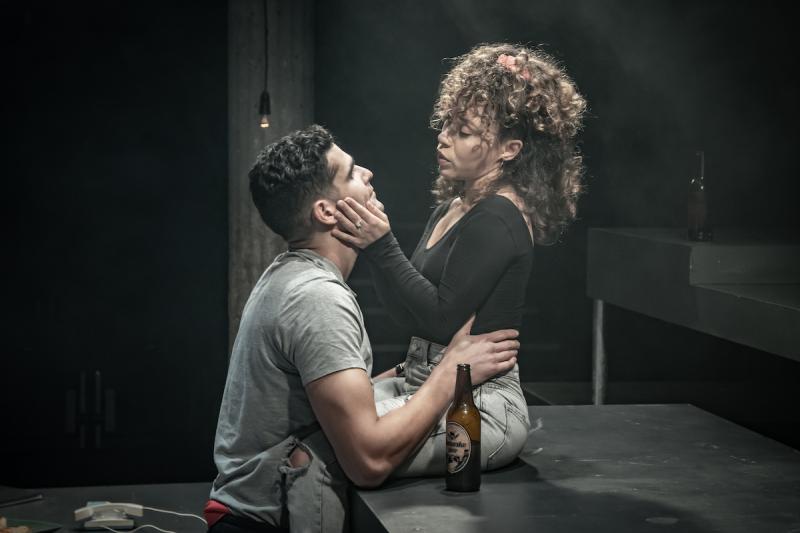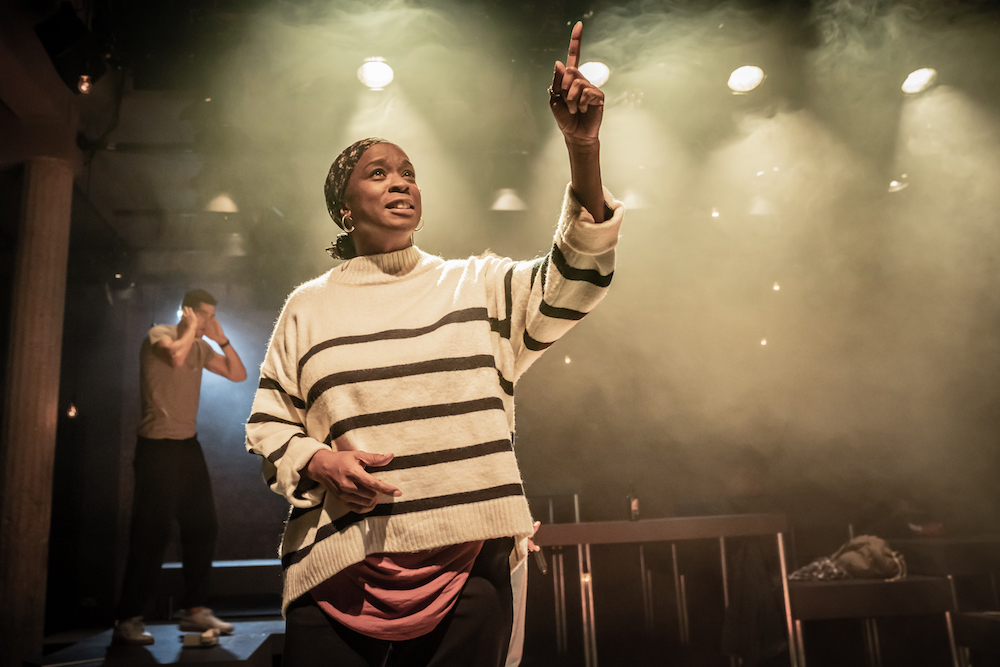Old Bridge, Bush Theatre review - powerful, poetic and profound | reviews, news & interviews
Old Bridge, Bush Theatre review - powerful, poetic and profound
Old Bridge, Bush Theatre review - powerful, poetic and profound
New play about love during the Bosnian war is beautifully written and compelling

Is the Bosnian conflict of 1992–95 the war that Europe forgot? Maybe, although most fans of new writing for the British stage will remember its massacres as the inciting incident for Sarah Kane’s 1995 modern classic, Blasted. Certainly, this genocidal struggle in the heart of Europe not only etched its horror on everyone who heard about it, but also continues to inspire drama.
Set in Mostar, in Bosnia and Herzegovina, which in 1988 — when the action begins — is in the communist state of Yugoslavia, a relatively peaceful patchwork of different ethnicities and religions, the story starts with a dive. In front of the town’s population, there’s an annual diving contest in which hopefuls leap from the historic old bridge into the river below. Eek! This year the fearless jumpers include Mili, a muscular young Croatian who comes from Dubrovnik and is looking for a new life: he meets 18-year-old Mina and bam! the youngsters fall in love. Because he’s from a Catholic background and she’s a Muslim (although not a practising one) there’s a nice shade of Romeo and Juliet to this passionate rapport.
Memic brilliantly evokes a sense of place, describing Mostar’s old bridge — which, nerd note, has the same age as Shakespeare — as if it was a physical growth out of the stone on two sides of the town’s river and ravine; he not only pictures the diving contest as a heroic communal event, but also places the newcomer Mili among Mina’s best friends: the lively and strong-minded Leila and the irrepressibly provocative Sasha. Sasha’s tongue-in-cheek declaration that he is “a half-Catholic, one eighth German, Roma Jew with a Muslim great-great-something or other” describes the complexity of the religious and ethnic make-up of Mostar, where a mixture of different peoples could once share the same building.
But the tolerant party atmosphere of the opening passages, with their drinks and meze, is cruelly broken by the onset of civil war, which begins almost casually, as Yugoslavia disintegrates politically following the fall of the Berlin Wall. Then the fighting rapidly escalates. Memic shows the suddenness of the conflict, and its impact on daily life. Within a year, as the 50-year-old Muslim Emina remembers in the present, “one day all you care about is music, fashion, and boys — the next day there’s no food.” The horror of war is powerfully conveyed, and, by using two time periods (the early 1990s and today) Memic lets Emina, an often poetic narrator, plunge us back in time, back to anguish and anxiety. If some moments are desperately moving, and almost unbearably sad, the story is also about resilience. The old bridge is destroyed during the war, but it is then rebuilt; as many people survive as are killed. So the terrible scenes, described panoramically in a cinematic way, of survivors searching for their loved ones, each clutching a photograph, are balanced by memories of fun times. In the end, suggests Memic, if laughter can help you survive, then only words can set you free. And perhaps the cruellest fate is reserved for those trauma victims who cannot find a way to articulate their loss and longing. This is both emotionally intelligent and lovingly written — you really feel that the playwright, who left Mostar aged two, is telling his people’s story.
If some moments are desperately moving, and almost unbearably sad, the story is also about resilience. The old bridge is destroyed during the war, but it is then rebuilt; as many people survive as are killed. So the terrible scenes, described panoramically in a cinematic way, of survivors searching for their loved ones, each clutching a photograph, are balanced by memories of fun times. In the end, suggests Memic, if laughter can help you survive, then only words can set you free. And perhaps the cruellest fate is reserved for those trauma victims who cannot find a way to articulate their loss and longing. This is both emotionally intelligent and lovingly written — you really feel that the playwright, who left Mostar aged two, is telling his people’s story.
Memic’s text throbs with a real sensuous feeling for place: there are moments when your body tingles as his characters ask you to tread carefully, toes first and heel second, or when the jumpers’ toes curl or when they run through broken glass in bare feet. At the same time, he reminds us of the psychology of war: how when one death provokes a day of tears, but each succeeding death is less strongly felt, until, a resonant metaphor in COVID times, you build up an immunity. He also uses everyday objects, such as an old watch, as potent metaphors of identity. There is not much journalism here, and you might want to consult wiki about the history of Mostar during the Bosnian conflict, but in its place is something better instead: a lot of deep experiential matter.
Director Selma Dimitrijevic, designer Oli Townsend and movement director Georgina Lamb, together create a compelling and emotionally true staging of this strongly felt narrative, highlighting the piece’s poetry as well as its horrors. The cast is excellent, with Dino Kelly and Saffron Coomber portraying Mili and Mina’s journey from lighthearted flirting to desperation under fire with enormous candour and conviction. Equally good are Rosie Gray (Leila) and Emilio Iannucci (Sasha), who similarly travel from cheekiness to trauma. Susan Lawson-Reynolds (pictured above) plays Emina — who as the grown-up Mina is the narrator and custodian of memory — with an engaging freshness.
The cast make all the characters both believable and relatable, reminding us that the Bosnian war, and all violent conflicts, are shocking intrusions into normal daily life, with its ciggies, coffees, shots, pop songs, hip T-shirts and sexual attraction. As Emina takes us by the hand to time travel to a more innocent past, the characters animate the flat platforms of the stage, which transform from fun playgrounds to claustrophobic hiding places. What were once irrelevant distinctions between Bosnians and Croats become a matter of life and death, and the ghosts of those we once knew remain in our minds in the present. Old Bridge is a wonderful mixture of beguiling reminiscence and vivid terror: a profound piece of writing — I loved it.
rating
Share this article
The future of Arts Journalism
You can stop theartsdesk.com closing!
We urgently need financing to survive. Our fundraising drive has thus far raised £49,000 but we need to reach £100,000 or we will be forced to close. Please contribute here: https://gofund.me/c3f6033d
And if you can forward this information to anyone who might assist, we’d be grateful.

Subscribe to theartsdesk.com
Thank you for continuing to read our work on theartsdesk.com. For unlimited access to every article in its entirety, including our archive of more than 15,000 pieces, we're asking for £5 per month or £40 per year. We feel it's a very good deal, and hope you do too.
To take a subscription now simply click here.
And if you're looking for that extra gift for a friend or family member, why not treat them to a theartsdesk.com gift subscription?
more Theatre
 Macbeth, RSC, Stratford review - Glaswegian gangs and ghoulies prove gripping
Sam Heughan's Macbeth cannot quite find a home in a mobster pub
Macbeth, RSC, Stratford review - Glaswegian gangs and ghoulies prove gripping
Sam Heughan's Macbeth cannot quite find a home in a mobster pub
 The Line of Beauty, Almeida Theatre review - the 80s revisited in theatrically ravishing form
Alan Hollinghurst novel is cunningly filleted, very finely acted
The Line of Beauty, Almeida Theatre review - the 80s revisited in theatrically ravishing form
Alan Hollinghurst novel is cunningly filleted, very finely acted
 Wendy & Peter Pan, Barbican Theatre review - mixed bag of panto and comic play, turned up to 11
The RSC adaptation is aimed at children, though all will thrill to its spectacle
Wendy & Peter Pan, Barbican Theatre review - mixed bag of panto and comic play, turned up to 11
The RSC adaptation is aimed at children, though all will thrill to its spectacle
 Hedda, Orange Tree Theatre review - a monument reimagined, perhaps even improved
Scandinavian masterpiece transplanted into a London reeling from the ravages of war
Hedda, Orange Tree Theatre review - a monument reimagined, perhaps even improved
Scandinavian masterpiece transplanted into a London reeling from the ravages of war
 The Assembled Parties, Hampstead review - a rarity, a well-made play delivered straight
Witty but poignant tribute to the strength of family ties as all around disintegrates
The Assembled Parties, Hampstead review - a rarity, a well-made play delivered straight
Witty but poignant tribute to the strength of family ties as all around disintegrates
 Mary Page Marlowe, Old Vic review - a starry portrait of a splintered life
Tracy Letts's Off Broadway play makes a shimmeringly powerful London debut
Mary Page Marlowe, Old Vic review - a starry portrait of a splintered life
Tracy Letts's Off Broadway play makes a shimmeringly powerful London debut
 Little Brother, Soho Theatre review - light, bright but emotionally true
This Verity Bargate Award-winning dramedy is entertaining as well as thought provoking
Little Brother, Soho Theatre review - light, bright but emotionally true
This Verity Bargate Award-winning dramedy is entertaining as well as thought provoking
 The Unbelievers, Royal Court Theatre - grimly compelling, powerfully performed
Nick Payne's new play is amongst his best
The Unbelievers, Royal Court Theatre - grimly compelling, powerfully performed
Nick Payne's new play is amongst his best
 The Maids, Donmar Warehouse review - vibrant cast lost in a spectacular-looking fever dream
Kip Williams revises Genet, with little gained in the update except eye-popping visuals
The Maids, Donmar Warehouse review - vibrant cast lost in a spectacular-looking fever dream
Kip Williams revises Genet, with little gained in the update except eye-popping visuals
 Ragdoll, Jermyn Street Theatre review - compelling and emotionally truthful
Katherine Moar returns with a Patty Hearst-inspired follow up to her debut hit 'Farm Hall'
Ragdoll, Jermyn Street Theatre review - compelling and emotionally truthful
Katherine Moar returns with a Patty Hearst-inspired follow up to her debut hit 'Farm Hall'
 Troilus and Cressida, Globe Theatre review - a 'problem play' with added problems
Raucous and carnivalesque, but also ugly and incomprehensible
Troilus and Cressida, Globe Theatre review - a 'problem play' with added problems
Raucous and carnivalesque, but also ugly and incomprehensible
 Clarkston, Trafalgar Theatre review - two lads on a road to nowhere
Netflix star, Joe Locke, is the selling point of a production that needs one
Clarkston, Trafalgar Theatre review - two lads on a road to nowhere
Netflix star, Joe Locke, is the selling point of a production that needs one

Add comment